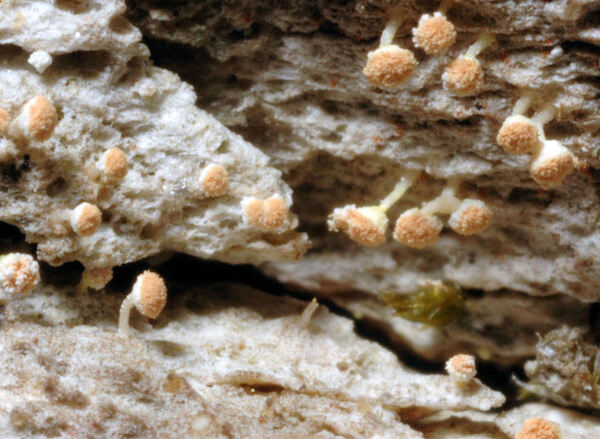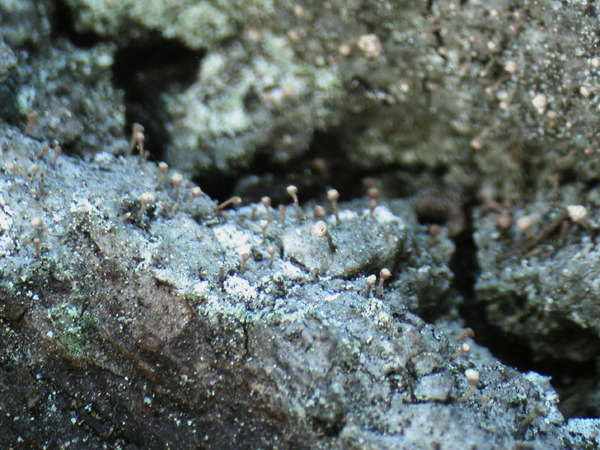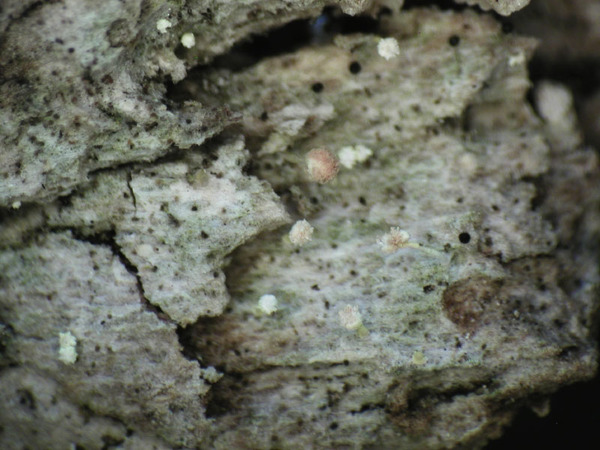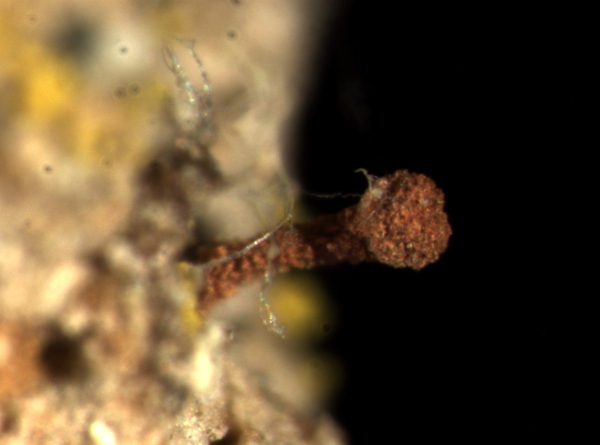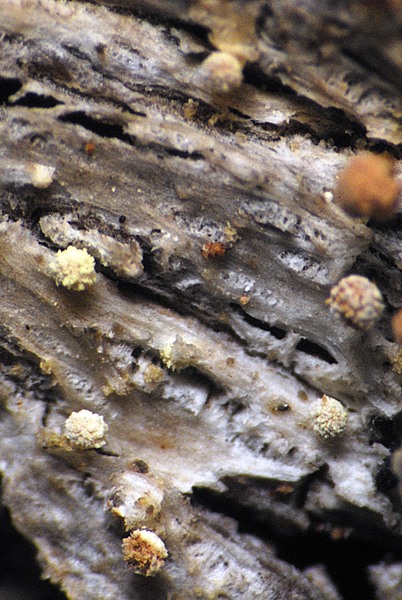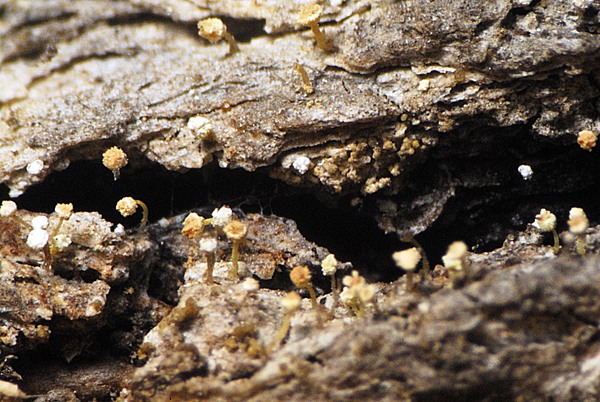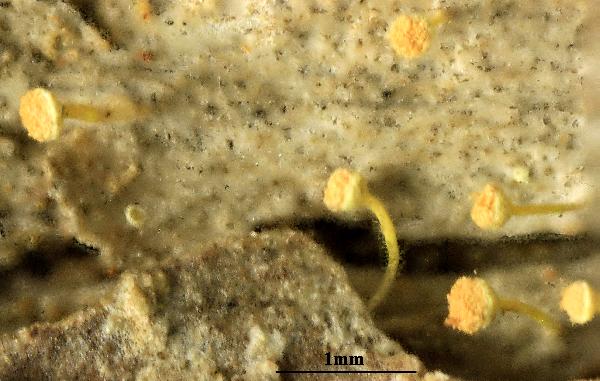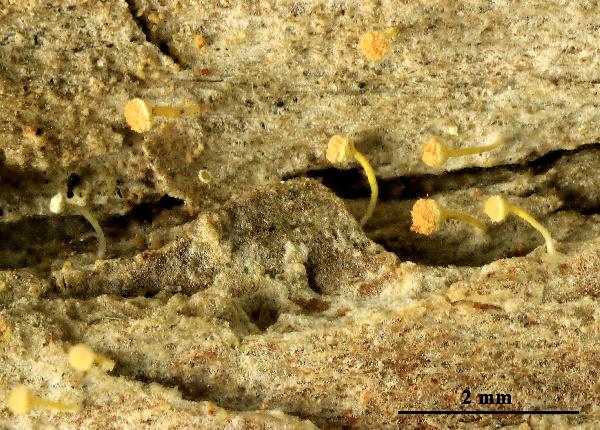Sclerophora pallida (Pers.) Y.J. Yao & Spooner
Kew Bull., 54, 3: 688, 1999. Basionym: Calicium pallidum Pers. - Ann. Bot. (Usteri), 7: 20, 1794.
Synonyms: Coniocybe curta H. Magn.; Coniocybe nivea var. pallida (Pers.) Arnold; Coniocybe pallida (Pers.) Fr.; Coniocybe pallida var. leucocephala (Wallr.) Schaer.; Coniocybe subpallida Nyl.; Sclerophora nivea (J.F. Gmel.) Tibell
Description: Thallus endosubstratic, poorly evident. Apothecia at first sessile and covered with a yellow pruina, then stalked and pin-like, 0.4-0.7 mm high, the stalk 0.06-0.1 mm thick, straw-yellow to pale grey in old specimens, epruinose, translucent when wet, consisting of hyaline, non-sclerotized, periclinally arranged hyphae. Capitulum broadly ovoid to lenticular, 0.25-0.32 mm across, the mazaedium well developed, pale ochraceous, densely inspersed with minute, dark yellow crystals. Exciple well-developed, forming a basal collar, of anticlinally oriented, hyaline hyphae, the surface covered in a layer of colourless to yellow crystals (pruina); hypothecium pale yellowish brown, with a slightly convex upper surface. Asci clavate, with a single functional wall layer, without apical structures, K/I-, dissolving at early stages, formed singly from ascogenous hyphae with croziers, with 2-seriately arranged ascospores. Ascospores 1-celled, globose, hyaline, 7-8 µm wide, with a verrucose ornamentation. Photobiont trentepohlioid. Spot tests: all parts of the ascomata including the yellow pruina K-, C-, KC-, P-, except the crystals in the mazaedium, which react K+ fleeting purple-violet (often with the formation of large crystals). Chemistry: thallus without lichen substances.
Growth form: Crustose
Substrata: bark
Photobiont: Trentepohlia
Reproductive strategy: mainly sexual
In underhangs rarely wetted by rain
Commonnes-rarity: (info)
Alpine belt: absent
Subalpine belt: absent
Montane belt: extremely rare
Dry submediterranean belt: extremely rare
Humid submediterranean belt: extremely rare
Padanian area: absent
pH of the substrata:
1 2 3 4 5
Solar irradiation:
1 2 3 4 5
Aridity:
1 2 3 4 5
Eutrophication:
1 2 3 4 5
Poleotolerance:
0 1 2 3
Altitudinal distribution:
1 2 3 4 5 6
Rarity
absent
extremely rare
very rare
rare
rather rare
rather common
common
very common
extremely common
Loading data...
Occurrence data
Predictive map
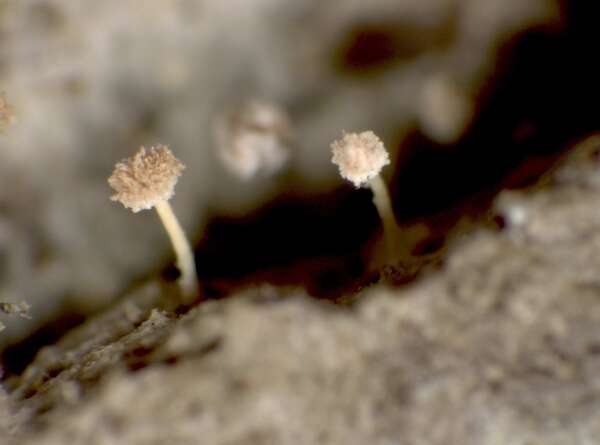
P.L. Nimis; Owner: Department of Life Sciences, University of Trieste
Herbarium: TSB (26667)
2001/11/30
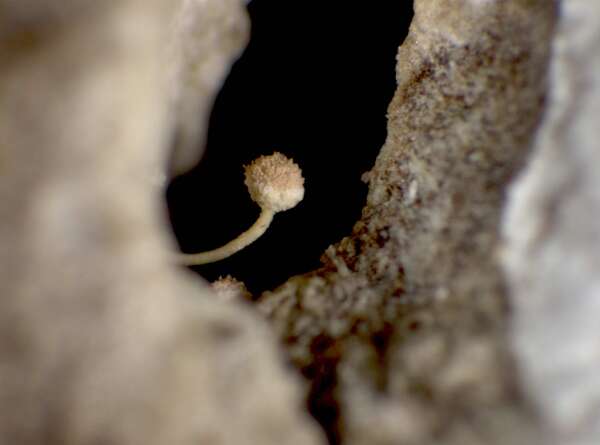
P.L. Nimis; Owner: Department of Life Sciences, University of Trieste
Herbarium: TSB (26667)
2001/11/30
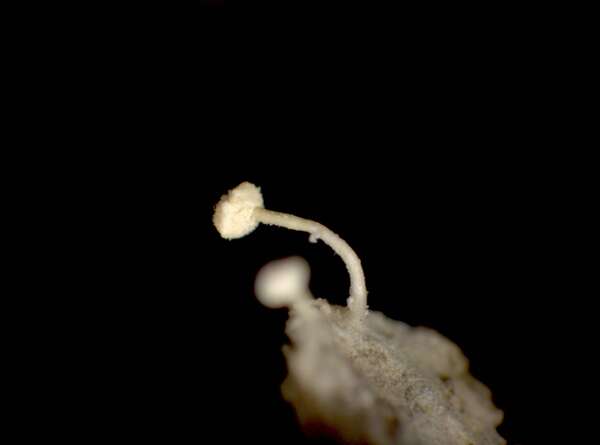
P.L. Nimis; Owner: Department of Life Sciences, University of Trieste
Herbarium: TSB (26667)
2001/11/30
Growth form: Crustose
Substrata: bark
Photobiont: Trentepohlia
Reproductive strategy: mainly sexual
In underhangs rarely wetted by rain
Commonnes-rarity: (info)
Alpine belt: absent
Subalpine belt: absent
Montane belt: extremely rare
Dry submediterranean belt: extremely rare
Humid submediterranean belt: extremely rare
Padanian area: absent
pH of the substrata:
| 1 | 2 | 3 | 4 | 5 |
Solar irradiation:
| 1 | 2 | 3 | 4 | 5 |
Aridity:
| 1 | 2 | 3 | 4 | 5 |
Eutrophication:
| 1 | 2 | 3 | 4 | 5 |
Poleotolerance:
| 0 | 1 | 2 | 3 |
Altitudinal distribution:
| 1 | 2 | 3 | 4 | 5 | 6 |
Rarity
absent
extremely rare
very rare
rare
rather rare
rather common
common
very common
extremely common
Loading data...
Occurrence data
Predictive map

P.L. Nimis; Owner: Department of Life Sciences, University of Trieste
Herbarium: TSB (26667)
2001/11/30

P.L. Nimis; Owner: Department of Life Sciences, University of Trieste
Herbarium: TSB (26667)
2001/11/30



